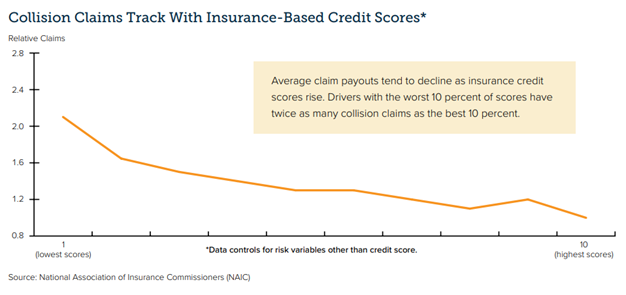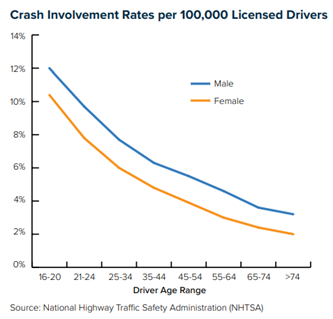[ad_1]

Two payments proposed in Illinois this yr illustrate but once more the necessity for lawmakers to raised perceive how insurance coverage works. Illinois HB 4767 and HB 4611 – like their 2023 predecessor, HB 2203 – would hurt the very policyholders the measures intention to assist by driving up the price for insurers to write down private auto protection within the state.
“These payments, whereas supposed to deal with rising insurance coverage prices, would have the other influence and sure hurt customers by decreasing competitors and growing prices for Illinois drivers,” mentioned a press launch issued by the American Property Casualty Insurance coverage Affiliation, the Illinois Insurance coverage Affiliation, and the Nationwide Affiliation of Mutual Insurance coverage Corporations. “Insurance coverage charges are initially a operate of claims and their prices. Somewhat than working to assist make roadways safer and cut back prices, these payments search to vary the state’s insurance coverage ranking legislation and prohibit using elements which can be extremely predictive of the danger of a future loss.”
The proposed legal guidelines would bar insurers from contemplating nondriving elements which can be demonstrably predictive of claims when setting premium charges.
“Prohibiting extremely correct ranking elements…disconnects worth from the danger of future loss, which essentially means high-risk drivers can pay much less and lower-risk drivers can pay greater than they in any other case would pay,” the discharge says. “Moreover, altering the ranking legislation and elements used won’t change the economics or crash statistics which can be the first drivers of the price of insurance coverage within the state.”
Triple-I agrees with the important thing issues raised by the opposite commerce organizations. As now we have written beforehand, such laws suggests a lack of knowledge about risk-based pricing that’s not remoted to Illinois legislators – certainly, related proposals are submitted sometimes at state and federal ranges.
What’s risk-based pricing?
Merely put, risk-based pricing means providing totally different costs for a similar degree of protection, based mostly on threat elements particular to the insured particular person or property. If insurance policies weren’t priced this manner – if insurers needed to give you a one-size-fits-all worth for auto protection that didn’t take into account car sort and use, the place and the way a lot the automobile will likely be pushed, and so forth – lower-risk drivers would subsidize riskier ones. Danger-based pricing permits insurers to supply the bottom potential premiums to policyholders with probably the most favorable threat elements. Charging greater premiums to insure higher-risk policyholders permits insurers to underwrite a wider vary of coverages, thus bettering each availability and affordability of insurance coverage.
This straightforward idea turns into difficult when actuarially sound ranking elements intersect with different attributes in methods that may be perceived as unfairly discriminatory. For instance, issues have been raised about using credit-based insurance coverage scores, geography, residence possession, and motorcar data in setting residence and automobile insurance coverage premium charges. Critics say this could result in “proxy discrimination,” with individuals of coloration in city neighborhoods generally charged greater than their suburban neighbors for a similar protection.
The confusion is comprehensible, given the advanced fashions used to evaluate and worth threat and the socioeconomic dynamics concerned. To navigate this complexity, insurers rent groups of actuaries and knowledge scientists to quantify and differentiate amongst a variety of threat variables whereas avoiding unfair discrimination.
Whereas it might be laborious for policyholders to imagine elements like age, gender, and credit score rating have something to do with their chance of submitting claims, the charts beneath reveal clear correlations.


Policyholders have affordable issues about rising premium charges. It’s vital for them and their legislators to grasp that the present high-rate setting has nothing to do with the appliance of actuarially sound ranking elements and every little thing to do with growing insurer losses related to greater frequency and severity of claims. Frequency and claims developments are pushed by a variety of causes – resembling riskier driving conduct and authorized system abuse – that warrant the eye of policymakers. Legislators would do properly to discover methods to scale back dangers, comprise fraud different types of authorized system abuse, and enhance resilience, quite than pursuing “options” to limit pricing that may solely make these drawback worse.
Be taught Extra
New Triple-I Points Transient Takes a Deep Dive into Authorized System Abuse
How Proposition 103 Worsens Danger Disaster in California
Louisiana Nonetheless Least Inexpensive State for Private Auto, Owners Insurance coverage
IRC Outlines Florida’s Auto Insurance coverage Affordability Issues
Colorado’s Life Insurance coverage Information Guidelines Supply Glimpse of Future for P&C Writers
It’s Not an “Insurance coverage Disaster” – It’s a Danger Disaster
Indiana Joins March Towards Disclosure of Third-Celebration Litigation Funding Offers
Litigation Funding Regulation Discovered Missing in Transparency Division
[ad_2]

